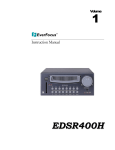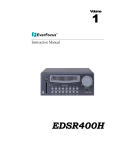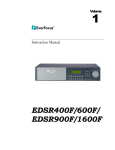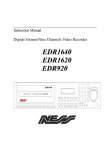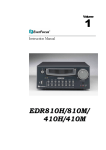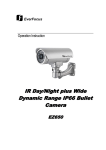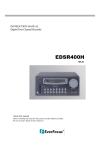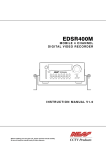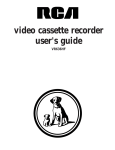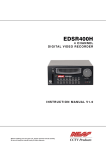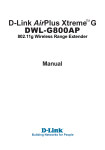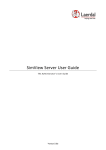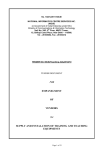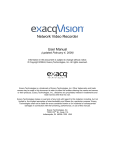Download Compex Systems DVR4-80 User's Manual
Transcript
DVR4-80 Users Manual and Installation Instructions DVR4-80 Users Manual Safety Precautions • • • • • • • • Refer all work related to the installation of this product to qualified service personnel or system installers. Do not block the ventilation opening or slots on the cover. Do not drop metallic parts through slots. This could permanently damage the appliance. Turn the power off immediately and contact qualified service personnel for service. Do not attempt to disassemble the appliance. To prevent electric shock, do not remove screws or covers. There are no user-serviceable parts inside. Contact qualified service personnel for maintenance. Handle the appliance with care. Do not strike or shake, as this may damage the appliance. Do not expose the appliance to water or moisture, nor try to operate it in wet areas. Do take immediate action if the appliance becomes wet. Turn the power off and refer servicing to qualified service personnel. Moisture may damage the appliance and also cause electric shock. Do not use strong or abrasive detergents when cleaning the appliance body. Use a dry cloth to clean the appliance when it is dirty. When the dirt is hard to remove, use a mild detergent and wipe gently. Do not overload outlets and extension cords as this may result in a risk of fire or electric shock. Do not operate the appliance beyond its specified temperature, humidity or power source ratings. Do not use the appliance in an extreme environment where high temperature or high humidity exists. Use the appliance at temperature within 0oC ~ +40oC and a humidity below 90%. The input power source for this appliance is AC100~240V. UNPACKING Unpack carefully. If an item appears to have been damaged in shipment, replace it properly in its carton and notify the shipper. If any items are missing, notify your General Lock LLC Sales Representative or Customer Service. The shipping carton is the safest container in which the unit may be transported. Save it for possible future use. Service If the unit ever needs repair service, the customer should contact the nearest General Lock LLC Service Center for return authorization and shipping instruction. Table of Contents Introduction CHAPTE R I 1 Product Overview 1 Features 1 Specifications 2 Front Panel Keys 3 Back Panel Keys 5 CHAPTE R 2 Installation 8 Basic Wiring Instructions 9 Hard Disk Drive Installation 10 Final Install Process 10 CHAPTE R 3 CHAPTE R Recording Overview 40 Basic Recording Setup 40 Timer Recording Setup 41 Motion Recording Setup 42 Alarm Recording Setup 43 CHAPTE R 11 Clock/Language Setting Menu 12 Title Setting Menu 14 Daylight Setting Menu 15 Timer Setting Menu 17 Normal Record Setting Menu 19 Alarm Record Setting Menu 21 Buzzer Setting Menu 24 Archive Setting Menu 26 Network Setting Menu 28 Sequence Setting Menu 30 RS232/RS485 Setting Menu 32 Motion Setting Menu 35 System Setting Menu 38 5 Playback Overview 45 Basic Playback 45 Search Playback 46 Segment List Playback 46 Alarm List Playback 47 Date/Time Playback 48 CHAPTE R DVR Menu Setup 4 6 Copying Video 50 Still Image Copy 50 Copy as a MOV File 51 Other Archiving Methods 52 Viewing Copied Files 52 CHAPTE R 7 Audio Overview CHAPTE R 53 8 How to Upgrade Firmware? CHAPTE R 54 9 Networking Overview 56 Introduction to TCP/IP 56 Subnet Masks 56 Gateway Address 57 Virtual Ports 57 CHAPTE R Pre-Installation 58 Viewing through Internet Explorer What type of Network Connection 59 Simple One to One Connection 60 CHAPTE R Direct High Speed Modem Connection 66 Interface Specifications 89 Router or LAN Connection 68 Transmission Setting 90 Remote Control Protocol 90 CHAPTE R 71 APPENDI X Dynamic DNS 75 Remote Control 11 14 APPENDI X D-Link Port Forwarding 77 Dynamic DNS 80 12 A 93 B Time Lapse Recording Time APPENDI X CHAPTE R 85 10 Linksys Port Forwarding CHAPTE R 13 C Alarm Board Configuration DDNS 82 Creating a DDNS Account 82 94 96 TROUBL E SHOOTIN G Troubleshooting 99 E V E R F O C U S E L E C T R O N I C S C O R P O R A T I O N Chapter 1 Product Overview DVRs are the industry’s first full-featured digital video recorder designed specifically for use within the security industry. The Digital Video Recorder incorporates all the benefits of digital video recording, is simple to install, and operates just like a VCR. Highly efficient compression technology and superior resolution of recorded images make the Digital Video Recorder stand out from the competition as the best choice for security surveillance. Features ¾ ¾ ¾ ¾ ¾ ¾ ¾ ¾ ¾ ¾ ¾ ¾ ¾ ¾ ¾ ¾ Easy-to-use control panel with common VCR and Multiplexer functions. Shuttle/Jog dial for picture-by-picture or fast/slow viewing. No tapes to manage, clean, or replace. Instant retrieval of stored video. On-screen setup menu and system timer. Ethernet TCP/IP connectivity for remote viewing. Pre-Alarm and Post-Alarm process. Built-in M-JPEG compression/decompression with configurable quality. Programmed with various time-lapse speeds. 3.5” IDE Type Hard Disks for storage with Hot-Swap tray. RS232 and RS485 for Remote Control. Real-Time Live Display for all Cameras. Variable recording speeds up to 60/50 fps for NTSC/PAL. Alarm-activated recording. Data can be stored in a Compact Flash Card. Audio recording capabilities. 1 E V E R F O C U S E L E C T R O N I C S C O R P O R A T I O N Specifications Video Format Video Input Video Output NTSC/PAL 4 camera inputs (BNC),1Vp-p/75ohm 1 BNC video out (1Vp-p/75 ohm) for Main Monitor 1 BNC video out (1Vp-p/75 ohm) for CALL Monitor 4 video out (1Vp-p/75ohm)for looping Video Compression M-JPEG Recording Resolution Compact Flash Memory Alarm Input Alarm Output Video Display Video Loss Detection Ethernet Event Log Hard Disk Storage Recording Mode 720x484 (NTSC); 720x576 (PAL) Yes, Built-in Compact Flash card slot 4 alarm inputs 1 alarm outputs Full, PIP, Quad and 2x2 zoom for Live and Playback Yes RJ45 connectors for network communications Yes 3.5” IDE type, Hot- swappable Continuous, Time-lapse recording, Schedule or Event Recording Up to 60/50 fps for NTSC/PAL Up to 60/50 fps for NTSC/PAL By Date/Time or Event/Segment On screen display setup Menu Driven Front Panel Keypad Built-in real time clock Yes 9-pin female connector RJ11 Connector 320.8mm (L) x 215mm (W) x 100mm (H) 0C~+40C 60 W AC100~240V Recording Rate Playback Rate Playback Search Setup User Interface User Input Device Timer Watch Dog Timer RS-232 RS485 Dimension Operating Temperature Power Consumption Power Source 2 E V E R F O C U S E L E C T R O N I C S C O R P O R A T I O N Front Panel Keypads 17 1 18 2 3 4 5 6 7 19 8 22 20 9 10 11 12 13 14 15 16 21 Keys: 1 5 6 7 CH1 ~CH4: Press channel key (1~4) to display the video image in full screen format for the channel specified. MODE: Press to switch between Picture-In-Picture and Quad modes. ~ 4 ZOOM: Pressing this key while viewing a full screen image will display a magnified resolution of the image on the monitor. SEQ: Press this key to enter the auto sequential switching mode. 8 MENU: Press this key to enter Setup menu. 9 REC : Press this key to start recording. 10 REV. PLAY : Pressing this key will start reverse playback. 11 STOP : Press this key to stop recording and playback. 12 PLAY: Press this key to playback. 13 PAUSE: Press this key to pause the playback picture. 14 SEARCH: Press this key to enter the Search Menu. 15 COPY: Under PAUSE or PLAYBACK, Press this key to start copy still picture or video stream onto a Compact Flash card. 3 E V E R F O C U S 16 E L E C T R O N I C S C O R P O R A T I O N Display: Pressing this key once will turn the display on. Pressing it a second time will give you Hard Disk Drive statistics. CH1 CH2 CH1 2003/04/22 10:41:00 Disk:120 GB(0) CH3 Display OFF 17 18 19 CH2 2003/04/22 10:42:00 CH4 CH3 LIVE: 60IPS DISK:80G CH4 Display Date/Time and Titles HDD KEY: Turning this key to the lock position will activate the Hard Drive for recording and keep it securely locked into the DVR. Hard Disk Tray: Hard Disk holder for HDD. Shuttle and Jog Dial Shuttle : In Playback mode, turn the shuttle dial can fast forward/rewind the picture. In Pause mode, turn the shuttle dial can slow forward/rewind the picture. Jog Dial : In Pause mode, turn the jog dial can forward/rewind the Picture. In Menu mode turn the jog dial to change setting Menu page. 20 Compact Flash Card Slot: Insert a Compact Flash Card. 21 LEDs: LEDs for system active power ,LAN and ALARM access. 22 Remote Control: IR Remote receiver 4 E V E R F O C U S E L E C T R O N I C S C O R P O R A T I O N Back Panel Connections 10 3 8 1 6 5 2 7 4 9 POWER 1 Main Power plug: Connect the DC12~24V power source to Adapter for AC100~240V. AUDIO 2 Audio IN: Audio input for recording. Audio OUT: Audio output can be set to “ON” or “OFF” in Setup Menu. ( Internal circuit ) SW2 OFF / Mute SW1 Playback Audio A Audio IN Audio OUT Operation of SW2: Operation of SW1: When in recording or standby mode, the out of SW1 is connected to Audio IN. When in playback mode the out of SW1 is connected to SW2 Audio. When Playback Audio is enabled then the output of SW2 will be connected to Playback Audio. When Playback Audio is disabled then there is no audio output (MUTE). When Audio Out is enabled and machine is in Recording or Standby mode, the Audio IN is loopthrough to Audio Out connector. When Audio Out is enabled and machine is in Playback mode then the Audio Out playback audio. 5 E V E R F O C U S E L E C T R O N I C S C O R P O R A T I O N MONITOR 3 4 MAIN MONITOR: This connector is used for the Main monitor display, a number of different display modes may be selected for viewing. This output must be used to display the menu settings. CALL MONITOR: This connector is used for the Call (secondary) monitor. This monitor can only display full screen pictures. ( Internal circuit ) SW3 MAIN MONITOR A INTERNAL VIDEO MONITOR OUT When the machine is in Menu, Search or Copy mode, the internal Video is switched to Monitor Out, so that the user can view full screen OSD. In other modes, the Video from multiplexer main monitor will be loop-through to the Monitor Out. VIDEO In/Output 5 VIDEO IN (1~4): The BNC connectors of video input enable the system to receive the signals from each camera through the 75 ohm coaxial cables. VIDEO OUT (1~4): Sends the signals from each camera to other external devices (loop out). Alarm Input/ Output 6 Alarm Input ALARM-INPUT: Normal Open or Normal Close type alarm sensor input. The Alarm Input can be selected as Normal Open or Normal Close input in the setup menu. When an alarm occurs, alarm recording will automatically start. ALARM-OUTPUT: Normal Close Alarm output. In normal condition, this terminal is shorted to the terminal of ALARM-COM. In alarm status, it is open between ALARM-NC and ALARM-COM terminals. LAN 7 LAN Connector: The RJ-45 LAN connector used to connect to a local area network. 6 E V E R F O C U S E L E C T R O N I C S C O R P O R A T I O N RS232 8 RS232 connector: Connect D-Sub 9 pin connector to RS232 port for remote control. RS485 9 RS485 connector: RJ 45 Connector to Cascade multi Digital Video Recorder. 10 FAN: Cooling FAN. 7 E V E R F O C U S E L E C T R O N I C S C O R P O R A T I O N Chapter 2 Installation The installations described below should be made by qualified service personnel or system installers. Please refer to the following diagram for the basic wiring connections. ¾ Please note: Monitors and Cameras must be purchased separately. Audio Input Main Monitor RS232 Camera 1~4 Power Source Alarm In/Out RS485 Ethernet Speaker CALL Monitor Diagram 1 8 E V E R F O C U S E L E C T R O N I C S C O R P O R A T I O N Basic Wiring Instructions Please refer to diagram 1 on page 9 to assist you with this portion of the installation. ¾ Power: Connect the power source or adapter into the power socket shown in diagram 1. Please note: Do not plug the digital video recorder into the same power source as the cameras. ¾ Cameras: Connect each cameras video output to the video input on the digital video recorder shown in diagram 1. Please note: At least one camera must be connected before the system is running for the auto detection of video standard to take effect. ¾ Audio Input: The camera audio output or Microphone is connected to the audio input terminal at the rear panel. ¾ Speaker: Connect the speaker or other audio listening devices to the audio output terminal on the back of the digital video recorder. ¾ Ethernet: The digital video recorder may be viewed from a PC via the LAN connector using a RJ45 Ethernet cable. ¾ RS232/RS485: The digital video recorder may be controlled from a PC via RS232/RS485. Please note: This can be done using a serial cable. ¾ Main Monitor: Connect the main monitor output connector to a main monitor. The main monitor displays selected live or recorded cameras in any available format. Please note: The main monitor must be connected in order to make configuration changes, enter the main menu, or do a playback at the machine. ¾ Call Monitor: Connect the call monitor output connector to a call monitor. The call monitor displays selected live cameras in full screen format. Please note: The call monitor will only display one full screen camera at a time. 9 E V E R F O C U S E L E C T R O N I C S C O R P O R A T I O N Hard Disk Drive Installation The first step in installing the hard drive is to insert the hard drive sleeve into the machine. The hard disk drive default setting is initially set to master. The second step is to insert the key provided and turn the tray key to the lock position. If this process is ignored the hard disk drive will not be detected. Please note: If the Hard Disk Drive is not locked in with the key a system loading screen will keep flashing and the DVR will not go into record mode. Final Install Process Once you have completed the basic wiring installation and the hard disk drive installation you are read to turn on the DVR. Simply plug the power source you installed earlier. The POWER LED lights will light up if power is normal. The next step is to set up the menu options for the DVR. 10 E V E R F O C U S E L E C T R O N I C S C O R P O R A T I O N Chapter 3 DVR Menu Setup Assuming you have completed the first two chapters of this manual. You are now ready to begin setting up the digital video recorder menu. To begin this process press the MENU key. Once inside the main menu you will find there are 13 setup option pages as follows. 1. CLOCK/LANGUAGE SETTING MENU 2. TITLE SETTING MENU 3. DAYLIGHT SAVING SETTING MENU 4. TIMER SETTING MENU 5. NORMAL RECORD SETTING MENU 6. ALARM RECORD SETTING MENU 7. BUZZER SETTING MENU 8. ARCHIVE SETTING MENU 9. NETWORK SETTING MENU 10. SEQUENCE SETTING MENU 11. RS232/RS485 SETTING 12. MOTION RECORD SETTING MENU 13. SYSTEM SETTING MENU Turning the jog dial clockwise or counter clockwise will allow you to scroll through the different menu setup option pages. 11 E V E R F O C U S E L E C T R O N I C S C O R P O R A T I O N Clock/Language Setting Menu Diagram 2 Diagram two is a screen shot of the Clock/Language Setting Menu. In the Clock/Language Setting Menu the following fields are defined as follows: ¾ Date: This field represents the current date on the DVR. To change this, simply use the arrow keys on the DVR which also represent the channel 14 keys (These are the top four buttons). Use the up and down arrow keys to make your selection. The date is represented as follows: Year: 2000~2099 / Month: 01~12 / Date: 01~31 (Day of Week) ¾ Time: This field represents the current time on the DVR which is in military time. To change this, simply use the arrow keys on the DVR which also represent the channel 1-4 keys (These are the top four buttons). Use the up and down arrow keys to make your selection. The date is represented as follows: Hour: 00~23 : Minute: 00~59 : Second: 00~59 12 E V E R F O C U S E L E C T R O N I C S C O R P O R A T I O N ¾ Menu Language: This field is set to English from factory and can not be changed. ¾ Video System: This field is set to NTSC from factory which is the North American Video Standard and can not be changed. The European and Asian Video Standards are PAL. ¾ Version: This field represents the firmware version the digital video recorder is using. Please note: New firmware versions are available for download from our ftp site. (see page for firmware upgrade instructions) ¾ Release Date: This field represents the date the firmware was released. : Press or to move the cursor to the left or right. : Press or to change the value. These keys are located at the top left row of keys (same keys as channel 1-4). 13 E V E R F O C U S E L E C T R O N I C S C O R P O R A T I O N Title Setting Menu Diagram 3 Diagram three is a screen shot of the Title Setting Menu. In this menu you can set a unique title for each of your cameras. To change this, simply use the arrow keys on the DVR which also represent the channel 1-4 keys (These are the top four buttons). Use the up and down arrow keys to make your selection. ¾ Example: CH1 CH2 CH3 CH4 : : : : FrontDoor BackDoor Hallway Closet : Press or to move the cursor to the left or right. : Press or to change the value. These keys are located at the top left row of keys (same keys as channel 1-4). 14 E V E R F O C U S E L E C T R O N I C S C O R P O R A T I O N Daylight Setting Menu Diagram 4 Diagram four is a screen shot of the Daylight Saving Setting Menu. In this menu you can set the DVR to adjust the daylight savings time automatically for you. ¾ Daylight saving: This field is to turn the daylight savings function on or off. To change this, simply use the arrow keys on the DVR which also represent the channel 1-4 keys (These are the top four buttons). Use the up and down arrow keys to make your selection. ¾ Start Time: This field signifies the date the daylight savings will take affect. The first field is set to “First”. This signifies the week of the month the daylight savings time will change. Your options are: first, second, third, fourth, or last. Use the up and down arrow keys to make your selection. The next field is set to “Sun”. This represents the day of the week the daylight savings time will take affect. Your options are: Sun, Mon, Tue, Wed, Thurs, Fri, or Sat. Use the up and down arrow keys to make your selection. 15 E V E R F O C U S E L E C T R O N I C S C O R P O R A T I O N The third field is set to “March”. This signifies the month in which the daylight savings time will occur. Your options are: Jan through Dec. Use the up and down arrow keys to make your selection. The last two fields represent the time. Use the up and down arrow keys to choose the time you want to go from to the time you want it to be. ¾ Stop Time: This field represents when the daylight savings time will come to an end. Use the same steps you used for the Start Time to make the necessary changes for the Stop Time. : Press or to move the cursor to the left or right. : Press or to change the value. These keys are located at the top left row of keys (same keys as channel 1-4). 16 E V E R F O C U S E L E C T R O N I C S C O R P O R A T I O N Timer Setting Menu Diagram 5 Diagram five is a screen shot of the Timer Setting Menu. In this menu you can set a unique timer any day of the week to start recording from a specified start time to an end time. In the Timer Setting Menu the following fields are defined as: ¾ Week: This field represents the day of the week you wish to set the timer record for. Initially it is set to Sun as default. You may choose from MonSun as well as DLY. If you wish to create a daily timer for every day of the week you may choose the DLY option. To change this, simply use the arrow keys on the DVR which also represent the channel 1-4 keys (These are the top four buttons). Use the up and down arrow keys to make your selection. ¾ Start: This field is used to set the time you wish to start the timer recording. To change this, simply use the arrow keys on the DVR which also represent the channel 1-4 keys (These are the top four buttons). Use the up and down arrow keys to make your selection. ¾ Stop: This field is used to set the time you wish to stop the timer recording. To change this, simply use the arrow keys on the DVR which also represent the channel 1-4 keys (These are the top four buttons). Use the up and down arrow keys to make your selection. 17 E V E R F O C U S E L E C T R O N I C S C O R P O R A T I O N ¾ Speed: This field is used to set the speed at which you would like the timer record to be recording at. To change this, simply use the arrow keys on the DVR which also represent the channel 1-4 keys (These are the top four buttons). Use the up and down arrow keys to make your selection. Please Note: See Appendix B to find the appropriate speed to fit your recording needs. ¾ Quality: This field is for setting up video recording quality, this item lets you set the quality of the video picture by selecting a compression rate. There are six quality levels for recording: Lower Low Basic Standard High Superior : : : : : : 15KB 19KB 23KB 27KB 31KB 35KB To change this, simply use the arrow keys on the DVR which also represent the channel 1-4 keys (These are the top four buttons). Use the up and down arrow keys to make your selection. ¾ Set: This field is used to turn the timer recording on or off. To change this, simply use the arrow keys on the DVR which also represent the channel 14 keys (These are the top four buttons). Use the up and down arrow keys to make your selection. Please note: If you wish to do any form of playback this feature must be turned off before attempting to playback. : Press or to move the cursor to the left or right. : Press or to change the value. These keys are located at the top left row of keys (same keys as channel 1-4). 18 E V E R F O C U S E L E C T R O N I C S C O R P O R A T I O N Normal Record Setting Menu Diagram 6 Diagram six is a screen shot of the Normal Record Setting Menu. This menu contains the speed and quality for recording all the time. In the Normal Record Setting Menu the following fields are defined as: ¾ Speed: This field represents the speed at which the recorder will be recording all the time. To change this, simply use the arrow keys on the DVR which also represent the channel 1-4 keys (These are the top four buttons). Use the up and down arrow keys to make your selection. Please Note: See Appendix B to find the appropriate speed to fit your recording needs. ¾ Quality: This field is for setting up video recording quality, this item lets you set the quality of the video picture by selecting a compression rate. There are six quality levels for recording: Lower Low Basic Standard : : : : 15KB 19KB 23KB 27KB 19 E V E R F O C U S E L E C T R O N I C S High Superior : : C O R P O R A T I O N 31KB 35KB To change this, simply use the arrow keys on the DVR which also represent the channel 1-4 keys (These are the top four buttons). Use the up and down arrow keys to make your selection. ¾ Disk Full: This field represents what to do when the Hard Disk Drive gets full. In this case the default is set to Rewrite. The other option if you wish to do so is to set the disk full option to Stop. This will stop all recording once the drive has been filled up. You would then have to go to System Setting Menu and do a Disk Renew in order to format the drive and start recording again. To change this, simply use the arrow keys on the DVR which also represent the channel 1-4 keys (These are the top four buttons). Use the up and down arrow keys to make your selection. : Press or to move the cursor to the left or right. : Press or to change the value. These keys are located at the top left row of keys (same keys as channel 1-4). 20 E V E R F O C U S E L E C T R O N I C S C O R P O R A T I O N Alarm Record Setting Menu Diagram 7 Diagram seven is a screen shot of the Alarm Record Setting Menu. This menu contains all the alarm operations and options needed to successfully complete an alarm recording. In the Alarm Record Setting Menu the following fields are defined as: ¾ Alarm Operations: This field is to turn alarm recording on or off. The Default from the factory is set to on. To change this, simply use the arrow keys on the DVR which also represent the channel 1-4 keys (These are the top four buttons). Use the up and down arrow keys to make your selection. ¾ Recording Speed: This field represents the speed at which the recorder will be recording the alarm event. To change this, simply use the arrow keys on the DVR which also represent the channel 1-4 keys (These are the top four buttons). Use the up and down arrow keys to make your selection. Please Note: See Appendix B to find the appropriate speed to fit your recording needs. ¾ Recording Quality: This field is for setting up video recording quality, this item lets you set the quality of the video picture for the alarm event by selecting a compression rate. 21 E V E R F O C U S E L E C T R O N I C S C O R P O R A T I O N There are six quality levels for recording: Lower Low Basic Standard High Superior : : : : : : 15KB 19KB 23KB 27KB 31KB 35KB To change this, simply use the arrow keys on the DVR which also represent the channel 1-4 keys (These are the top four buttons). Use the up and down arrow keys to make your selection. ¾ Alarm 1-4 Types: These fields represent what to do when a signal is received from the alarm board connector. There are two types of alarm signals. The first is N.O. which stands for Normally Open circuit. The Second is N.C. which stands for Normally Closed circuit. The default setting is N.O. This option would be set according to the type of alarm input connected to the alarm board. For example if you connected a door sensor which was a Normally Open circuit you would set the alarm type to N.O. To change this, simply use the arrow keys on the DVR which also represent the channel 1-4 keys (These are the top four buttons). Use the up and down arrow keys to make your selection. Please note: Refer to Appendix D for more information about setting up the alarm board. ¾ Alarm Reset Type: This field is to set the alarm signal back to normal. If you have a N.O. alarm in the alarm types you would set it back to N.O. If you have a N.C. circuit you would set it back to N.C. To change this, simply use the arrow keys on the DVR which also represent the channel 14 keys (These are the top four buttons). Use the up and down arrow keys to make your selection. ¾ Alarm Duration Time: When any sensor alarm connected to the device is activated, the device will immediately react an alarm and display the warning message. This entry is used to set the alarm duration from 1 to 99 seconds. To change this, simply use the arrow keys on the DVR which also represent the channel 1-4 keys (These are the top four buttons). Use the up and down arrow keys to make your selection. ¾ Pre-Alarm Operation: This feature turns the pre-alarm recording on or off. To change this, simply use the arrow keys on the DVR which also 22 E V E R F O C U S E L E C T R O N I C S C O R P O R A T I O N represent the channel 1-4 keys (These are the top four buttons). Use the up and down arrow keys to make your selection. ¾ Recording Speed: This option is to set the speed of the pre-alarm recording. To change this, simply use the arrow keys on the DVR which also represent the channel 1-4 keys (These are the top four buttons). Use the up and down arrow keys to make your selection. : Press or to move the cursor to the left or right. : Press or to change the value. These keys are located at the top left row of keys (same keys as channel 1-4). 23 E V E R F O C U S E L E C T R O N I C S C O R P O R A T I O N Buzzer Setting Menu Diagram 8 Diagram eight is a screen shot of the Buzzer Setting Menu. This menu is to set the internal buzzer. In the Buzzer Setting Menu the following fields are defined as: ¾ Buzzer: This field is to turn the internal buzzer enable or disable the internal buzzer. The default is set to enable. To change this, simply use the arrow keys on the DVR which also represent the channel 1-4 keys (These are the top four buttons). Use the up and down arrow keys to make your selection. ¾ Record-In: This option is to turn the buzzer on or off when the DVR is in record mode. To change this, simply use the arrow keys on the DVR which also represent the channel 1-4 keys (These are the top four buttons). Use the up and down arrow keys to make your selection. ¾ Alarm-In: This field is to turn the buzzer on or off when alarm recording is enabled. To change this, simply use the arrow keys on the DVR which also represent the channel 1-4 keys (These are the top four buttons). Use the up and down arrow keys to make your selection. ¾ Motion-In: This option is to turn the buzzer on or off when motion recording is enabled. To change this, simply use the arrow keys on the 24 E V E R F O C U S E L E C T R O N I C S C O R P O R A T I O N DVR which also represent the channel 1-4 keys (These are the top four buttons). Use the up and down arrow keys to make your selection. ¾ Disk Full: This field is to turn the buzzer on or off when the Hard Disk Drive is full. To change this, simply use the arrow keys on the DVR which also represent the channel 1-4 keys (These are the top four buttons). Use the up and down arrow keys to make your selection. ¾ Video Loss: This option is to turn the buzzer on or off when the DVR experiences video loss. To change this, simply use the arrow keys on the DVR which also represent the channel 1-4 keys (These are the top four buttons). Use the up and down arrow keys to make your selection. ¾ Timer: This field is to turn the buzzer on or off when timer recording is activated. To change this, simply use the arrow keys on the DVR which also represent the channel 1-4 keys (These are the top four buttons). Use the up and down arrow keys to make your selection. : Press or to move the cursor to the left or right. : Press or to change the value. These keys are located at the top left row of keys (same keys as channel 1-4). 25 E V E R F O C U S E L E C T R O N I C S C O R P O R A T I O N Archive Setting Menu Diagram 9 Diagram nine is a screen shot of the Archive Setting Menu. This menu is for setting up the way in which video is archived within the machine. In the Archive Setting Menu the following fields are defined as follows: ¾ Picture Size: This field is to set the picture size for copying an image to a Compact Flash card or through the network. Initial default is set to the larger size 720 x 480 for NTSC or 720 x 576 for PAL. The smaller size is 352 x 240 for NTSC or 352 x 288 for PAL. Please Note: To speed up refresh rate through the network set picture size to 352 x 240 for NTSC or 352 x 288 for PAL. To change this, simply use the arrow keys on the DVR which also represent the channel 1-4 keys (These are the top four buttons). Use the up and down arrow keys to make your selection. ¾ Time Stamp: This option is to turn the time stamp on or off when the DVR is in record mode. The time stamp will appear when archiving through the network or to a Compact Flash card. To change this, simply use the arrow keys on the DVR which also represent the channel 1-4 keys 26 E V E R F O C U S E L E C T R O N I C S C O R P O R A T I O N (These are the top four buttons). Use the up and down arrow keys to make your selection. ¾ Time Stamp Position: This field is to set the position of the time stamp. You can set the time position either on top or bottom. The default is set to top. To change this, simply use the arrow keys on the DVR which also represent the channel 1-4 keys (These are the top four buttons). Use the up and down arrow keys to make your selection. ¾ Water Mark: This option is to turn water mark on or off when copying to a Compact Flash card. By default this option is turned on. To change this, simply use the arrow keys on the DVR which also represent the channel 14 keys (These are the top four buttons). Use the up and down arrow keys to make your selection. ¾ Water Mark Pos: This field is set the water mark position. You can set the water mark to either the top or the bottom. The factory default is set to top. To change this, simply use the arrow keys on the DVR which also represent the channel 1-4 keys (These are the top four buttons). Use the up and down arrow keys to make your selection. : Press or to move the cursor to the left or right. : Press or to change the value. These keys are located at the top left row of keys (same keys as channel 1-4). 27 E V E R F O C U S E L E C T R O N I C S C O R P O R A T I O N Network Setting Menu Diagram 10 Diagram ten is a screen shot of the Network Setting Menu. This menu is for setting up the configuration for networking to the DVR. Please refer to the Networking Chapter of this manual to fully understand how to setup your network for this DVR. In the Network Setting Menu the following fields are defined as follows: ¾ IP Address: This field is to set a static IP Address for the DVR. A static IP address is an IP address whose value does not change. We suggest using a static IP address. If your Internet provider does not offer a static IP address you have the option to use a dynamic IP address. For Example: A Test IP address given to the machine by our engineers is 192.168.010.010. Please Note: The Addresses in the machine are for our own testing you must apply your own addresses to comply with your network. Refer to Networking Chapter for more details. To change this, simply use the arrow keys on the DVR which also represent the channel 1-4 keys (These are the top four buttons). Use the up and down arrow keys to make your selection. 28 E V E R F O C U S E L E C T R O N I C S C O R P O R A T I O N ¾ Net mask: This field is to set the subnet mask for your network so as the DVR will be recognized within the network. Example: 255.255.255.000 To change this, simply use the arrow keys on the DVR which also represent the channel 1-4 keys (These are the top four buttons). Use the up and down arrow keys to make your selection. ¾ Gateway: This field is to set the gateway for your network so the DVR will be recognized within the network. An example of this is provided within the DVR we use to test the machine within our own network. To change this, simply use the arrow keys on the DVR which also represent the channel 1-4 keys (These are the top four buttons). Use the up and down arrow keys to make your selection. ¾ Mac Address: This field is for those Internet service providers or Network administrators who require a MAC address of the network card of our DVR. This option can not be changed. ¾ User-Name Password Level: This category is to set up the users that will log into the network. Please remember that this portion of the Network setting menu is set up in column format. To change the any of the presets to a more user defined name simple use the arrow keys on the DVR which also represent the channel 1-4 keys (These are the top four buttons). Use the up and down arrow keys to make your selection. Example: Changed to USER-NAME admin Adam Password admin DVR Level super super Please remember there are only three different levels guest, general, and super. o “Admin” and “general” – can view live/playback video o “Guest” – can only view live. : Press or to move the cursor to the left or right. : Press or to change the value. These keys are located at the top left row of keys (same keys as channel 1-4). 29 E V E R F O C U S E L E C T R O N I C S C O R P O R A T I O N Sequence Setting Menu Diagram 11 Diagram eleven is a screen shot of the Sequence Setting Menu. This menu is for setting up the way in which video is sequenced through the main monitor and call monitor outputs. In the Sequence Setting Menu the following fields are defined as follows: ¾ Main Monitor: This field is to set the sequence for the main monitor output. Dwell Time: This field represents the rate at which the cameras will sequence on the main monitor. The dwell time for the auto sequence can be set from 0 to 99 seconds. To change this, simply use the arrow keys on the DVR which also represent the channel 1-4 keys (These are the top four buttons). Use the up and down arrow keys to make your selection. Seq with Quad: This field is to turn on or off the quad screen when the auto sequence mode is on. The default is set to yes. To turn it off simple change to no. To change this, simply use the arrow keys on the DVR which also represent the channel 1-4 keys (These are the top four buttons). Use the up and down arrow keys to make your selection. 30 E V E R F O C U S E L E C T R O N I C S C O R P O R A T I O N ¾ Call Monitor: This field is to set the sequence for the call monitor output. Dwell Time: This field represents the rate at which the cameras will sequence on the call monitor. The dwell time for the auto sequence can be set from 0 to 99 seconds. To change this, simply use the arrow keys on the DVR which also represent the channel 1-4 keys (These are the top four buttons). Use the up and down arrow keys to make your selection. Operation: This field is to select from camera 1 to 4 for the sequence screen. The default is set to CH1. To change this, simply use the arrow keys on the DVR which also represent the channel 1-4 keys (These are the top four buttons). Use the up and down arrow keys to make your selection. o Please Note: If an alarm occurs call monitor will display that particular camera automatically. : Press or to move the cursor to the left or right. : Press or to change the value. These keys are located at the top left row of keys (same keys as channel 1-4). 31 E V E R F O C U S E L E C T R O N I C S C O R P O R A T I O N RS232/RS485 Setting Menu Diagram 12 Diagram twelve is a screen shot of the RS232/RS485 Setting Menu. This menu is for setting up a connection from the digital recorder to a computer to transfer instructions or information using the HyperTerminal program in Windows. In the RS232/RS485 Setting Menu the following fields are defined as follows: RS232: ¾ RS232 Baud Rate: This field is to set the speed at which is used to transmit instruction or information through the RS232 port on the DVR. There are six different speeds, 1200 BPS, 2400 BPS, 4800 BPS, 9600 BPS, 19200 BPS, and 3840 BPS. The default setting from the factory is 9600 BPS. To change this, simply use the arrow keys on the DVR which also represent the channel 1-4 keys (These are the top four buttons). Use the up and down arrow keys to make your selection. ¾ RS232 Stop Bit: This field is to set the stop bit for the RS232 connection. There are two different stop bits, 1 or 2. The default in the DVR is set to 1. To change this, simply use the arrow keys on the DVR which also represent the channel 1-4 keys (These are the top four buttons). Use the up and down arrow keys to make your selection. 32 E V E R F O C U S E L E C T R O N I C S C O R P O R A T I O N ¾ RS232 Parity: This field is to select the parity level at which you will be connected. You can choose between None, Odd, or Even parity levels. Default is set to None. To change this, simply use the arrow keys on the DVR which also represent the channel 1-4 keys (These are the top four buttons). Use the up and down arrow keys to make your selection. ¾ RS232 Data Bit: This field is the data bit at which you will be transferring. There are two settings for this option: 8 or 7. The default is set to 8. To change this, simply use the arrow keys on the DVR which also represent the channel 1-4 keys (These are the top four buttons). Use the up and down arrow keys to make your selection. RS485: ¾ RS485 Baud Rate: This field is to set the speed at which is used to transmit instruction or information through the RS485 port on the DVR. There are six different speeds, 1200 BPS, 2400 BPS, 4800 BPS, 9600 BPS, 19200 BPS, and 3840 BPS. The default setting from the factory is 9600 BPS. To change this, simply use the arrow keys on the DVR which also represent the channel 1-4 keys (These are the top four buttons). Use the up and down arrow keys to make your selection. ¾ RS485 Stop Bit: This field is to set the stop bit for the RS485 connection. There are two different stop bits, 1 or 2. The default in the DVR is set to 1. To change this, simply use the arrow keys on the DVR which also represent the channel 1-4 keys (These are the top four buttons). Use the up and down arrow keys to make your selection. ¾ RS485 Parity: This field is to select the parity level at which you will be connected. You can choose between None, Odd, or Even parity levels. Default is set to None. To change this, simply use the arrow keys on the DVR which also represent the channel 1-4 keys (These are the top four buttons). Use the up and down arrow keys to make your selection. ¾ RS485 Data Bit: This field is the data bit at which you will be transferring. There are two settings for this option: 8 or 7. The default is set to 8. To change this, simply use the arrow keys on the DVR which also represent the channel 1-4 keys (These are the top four buttons). Use the up and down arrow keys to make your selection. 33 E V E R F O C U S E L E C T R O N I C S C O R P O R A T I O N ¾ RS232/RS485 ID: This entry is used to assign each device its own ID code if more than one unit is used through the RS232/RS485 connection. There are two ID codes for the DVR: 001 or 002. The default is set to 001. To change this, simply use the arrow keys on the DVR which also represent the channel 1-4 keys (These are the top four buttons). Use the up and down arrow keys to make your selection. : Press or to move the cursor to the left or right. : Press or to change the value. These keys are located at the top left row of keys (same keys as channel 1-4). 34 E V E R F O C U S E L E C T R O N I C S C O R P O R A T I O N Motion Record Setting Menu Diagram 13 Diagram thirteen is a screen shot of the Motion Record Setting Menu. This menu is for setting up the digital recorder for motion recording. In the Motion Record Setting Menu the following fields are defined as follows: ¾ Recording Speed: This field represents the speed at which the recorder will be recording when motion is detected. To change this, simply use the arrow keys on the DVR which also represent the channel 1-4 keys (These are the top four buttons). Use the up and down arrow keys to make your selection. Please Note: See Appendix B to find the appropriate speed to fit your recording needs. ¾ Quality: This field is for setting up video recording quality, this item lets you set the quality of the video picture by selecting a compression rate. There are six quality levels for recording: Lower Low Basic : : : 15KB 19KB 23KB 35 E V E R F O C U S E L E C T R O N I C S Standard High Superior : : : C O R P O R A T I O N 27KB 31KB 35KB To change this, simply use the arrow keys on the DVR which also represent the channel 1-4 keys (These are the top four buttons). Use the up and down arrow keys to make your selection. ¾ CH: This field represents the camera channels 1 through 4. ¾ OP: This field is to set the option of turning motion on or off. If OP is turned on the DVR will respond by recording when motion occurs. If OP is turned off the DVR will not record when motion occurs. To change this, simply use the arrow keys on the DVR which also represent the channel 1-4 keys (These are the top four buttons). Use the up and down arrow keys to make your selection. ¾ SEN: This entry signifies the sensitivity to pick up motion for each camera. There are four different sensitivity levels that can be used, High, Standard, Basic, Low. The default setting is standard. To change this, simply use the arrow keys on the DVR which also represent the channel 1-4 keys (These are the top four buttons). Use the up and down arrow keys to make your selection. ¾ Manual Edit: This field represents manual editing of each camera for motion. To change this, simply use the arrow keys on the DVR which also represent the channel 1-4 keys (These are the top four buttons). Use the up and down arrow keys to make your selection. Once you have chosen the channel you would like to manually edit, press the ENTER button. This will bring you to a new screen. 36 E V E R F O C U S E L E C T R O N I C S C O R P O R A T I O N ¾ Diagram 14 shows a screen shot of the manually edit screen. Use the arrow buttons to move through the squares. Initially all the squares are pink in color signifying that these squares are set up to pick up motion. To deselect a square simply move over the square and press the ENTER button. Diagram 15 shows another screen shot of a manually edited screen after editing has been accomplished. To exit this screen after you have finished editing simply press the MENU button. : Press or to move the cursor to the left or right. : Press or to change the value. These keys are located at the top left row of keys (same keys as channel 1-4). 37 E V E R F O C U S E L E C T R O N I C S C O R P O R A T I O N System Setting Menu Diagram 16 Diagram sixteen is a screen shot of the System Setting Menu. This menu is for setting up any additional options and restoring defaults to the digital recorder. In the System Setting Menu the following fields are defined as follows: ¾ Play with Audio: This field is to turn on audio while playing video which contains prerecorded audio. This option can be turned on or off. The default is set to on. To change this, simply use the arrow keys on the DVR which also represent the channel 1-4 keys (These are the top four buttons). Use the up and down arrow keys to make your selection. ¾ Disk Renew: This entry is to format the Hard Drive. Initially it is set to No. To format the Hard Drive simply use the arrow buttons to change this option to yes. This will bring up a second dialog which asks you if you want to do a disk renew again. Use the arrow buttons to select yes and press the enter button. Please Note: See Disk Renew Chapter for more details and diagrams. ¾ System Update: This field is to update the firmware in the system. Initially it is set to No. To Update the system simply use the arrow buttons to change this option to yes. This will bring up a second dialog which asks 38 E V E R F O C U S E L E C T R O N I C S C O R P O R A T I O N you if you want to do a system update again. Use the arrow buttons to select yes and press the enter button. Please Note: See System Update Chapter for more details and diagrams. Also after the system has updated successfully, be sure to cycle the power to the digital recorder by turning the power off and then back on. ¾ Load Default: This entry is to set the DVR back to factory settings. Please remember if you are having difficulties with your DVR we suggest restoring the defaults before calling Tech support. Initially Load defaults is set to No. To Load the defaults simply use the arrow buttons to change this option to yes. This will bring up a second dialog which asks you if you want to do a load defaults again. Use the arrow buttons to select yes and press the enter button. Please Note: See Load Defaults Chapter for more details and diagrams. Also after the system has loaded the defaults successfully, be sure to cycle the power to the digital recorder by turning the power off and then back on. ¾ Password Enable: This field is to turn the password function on or off. The default is set to No. If you would like to enable the password change this option to yes. To change this, simply use the arrow keys on the DVR which also represent the channel 1-4 keys (These are the top four buttons). Use the up and down arrow keys to make your selection. ¾ Password: This field is the password for the system when the password is enabled. The password supports up to 6 characters. The available alphanumeric characters are: 0 to 9, A to Z, and /( ) . - * & @ : ” To change this, simply use the arrow keys on the DVR which also represent the channel 1-4 keys (These are the top four buttons). Use the up and down arrow keys to make your selection. Please Note: For More information please refer to Password Chapter. : Press or to move the cursor to the left or right. : Press or to change the value. These keys are located at the top left row of keys (same keys as channel 1-4). 39 E V E R F O C U S E L E C T R O N I C S C O R P O R A T I O N Chapter 4 Recording Overview Before continuing please be sure to have reviewed DVR Menu Setup (Chapter 3). You are now ready to begin setting up the machine for normal recording. This chapter will show you how to setup the recorder for basic recording. Basic Recording Setup ¾ Assuming you have completed the setup options in Chapter 1 and 2. Log into the DVR menu by pressing the Menu button. Turning the jog dial clockwise or counter clockwise will allow you to scroll through the different menu setup option pages. ¾ Once You Reach the Normal Record Setting Menu (See Page 19) change the Recording speed and quality that best fits your application. Please Note: See Appendix B to find the appropriate speed to fit your recording needs. ¾ Once you have completed the previous step log out of the menu and hit the record button. ¾ To view the operating display (diagram 18), press the Display button. Diagram 18 40 E V E R F O C U S E L E C T R O N I C S C O R P O R A T I O N ¾ To stop recording simply press the Stop button. Please Note: When the Hard Drive is full, the DVR will either stop recording automatically or overwrite from the beginning of the hard drive. This is all dependent on what was set in the normal record setting (see page 19). Timer Recording Setup ¾ Assuming you have completed the setup options in Chapter 1 and 2. Log into the DVR menu by pressing the Menu button. Turning the jog dial clockwise or counter clockwise will allow you to scroll through the different menu setup option pages. ¾ Once You Reach the Normal Record Setting Menu (See Page 19) change the Recording speed and quality that best fits your application. Please Note: See Appendix B to find the appropriate speed to fit your recording needs. ¾ Use the jog dial after completing the previous step and go to Timer Record Setting menu (See Page 17). Setup a timer for your application and exit the menu by pressing the Menu button. Once you have exited the menu the DVR will go into record mode. ¾ To view the operating display (diagram 19), press the Display button. Diagram 19 ¾ To stop recording simply press the Stop button. 41 E V E R F O C U S E L E C T R O N I C S C O R P O R A T I O N Please Note: When the Hard Drive is full, the DVR will either stop recording automatically or overwrite from the beginning of the hard drive. This is all dependent on what was set in the normal record setting (see page 19). Motion Recording Setup ¾ Assuming you have completed the setup options in Chapter 1 and 2. Log into the DVR menu by pressing the Menu button. Turning the jog dial clockwise or counter clockwise will allow you to scroll through the different menu setup option pages. ¾ Once You Reach the Normal Record Setting Menu (See Page 19) change the Recording speed to 0.2 IPS and quality that best fits your application. ¾ Use the jog dial after completing the previous step and go to Motion Record Setting menu (See Page 35). Change the Recording speed and quality that best fits your application. Please Note: See Appendix B to find the appropriate speed to fit your recording needs. ¾ Exit the menu by pressing the Menu button. Once you have exited the menu if motion is occurring the DVR will go into record mode. Make sure you press the record button if not recording or if after motion has stopped the record light has gone off. Please Note: If you see the Record Light going on and off you are not recording properly in motion. This will eat up your hard drive space. To remedy this problem simply press the record button when the light goes off to stay in record mode continuously. ¾ To view the operating display (diagram 20), press the Display button. 42 E V E R F O C U S E L E C T R O N I C S C O R P O R A T I O N Diagram 20 ¾ To stop recording simply press the Stop button. Please Note: When the Hard Drive is full, the DVR will either stop recording automatically or overwrite from the beginning of the hard drive. This is all dependent on what was set in the normal record setting (see page 19). Alarm Recording Setup ¾ Assuming you have completed the setup options in Chapter 1 and 2. Log into the DVR menu by pressing the Menu button. Turning the jog dial clockwise or counter clockwise will allow you to scroll through the different menu setup option pages. ¾ Once You Reach the Alarm Record Setting Menu (See Page 21) change the Recording speed and quality that best fits your application. Please Note: See Appendix B to find the appropriate speed to fit your recording needs. ¾ Exit the menu by pressing the Menu button. Once you have exited the menu if an alarm occurs the DVR will go into record mode. ¾ To view the operating display (diagram 21), press the Display button. 43 E V E R F O C U S E L E C T R O N I C S C O R P O R A T I O N Diagram 21 ¾ To stop recording simply press the Stop button. Please Note: When the Hard Drive is full, the DVR will either stop recording automatically or overwrite from the beginning of the hard drive. This is all dependent on what was set in the normal record setting (see page 19). 44 E V E R F O C U S E L E C T R O N I C S C O R P O R A T I O N Chapter 5 Playback Overview Before continuing please be sure to have reviewed DVR Menu Setup (Chapter 3). You are now ready to begin setting up the machine for playback. This chapter will show you how to setup the recorder for basic playback. Basic Playback ¾ Assuming you have completed the setup options in Chapter 1 through 4. If you are in Record mode hit the stop button to stop recording. ¾ If the menu pops up when you press the stop button. This usually means you have either the DVR is in Timer record or Motion record. Log into the DVR menu by pressing the Menu button. Go to Either Timer Setting Menu or Motion Record Setting menu and turn them off. ¾ Once you have stopped any type of recording on the DVR you are ready to do playback. ¾ Pressing the play button will set the recorder into playback mode and play the last segment recorded. ¾ If you Press the Rev play button it will play the last known segment in reverse mode. ¾ At any point if you wish to fast forward or rewind while playing back simply use the shuttle dial to do so. The speed will be shown on the corner of the screen. << Or >> 2, 4, 6, 8, 16, 32, 600X. ¾ If you want to do a slow playback press the pause button anytime during playback. Then simply turn the shuttle clockwise or counter clockwise depending if you want to do a slow forward or slow rewind. The speed will be shown on the corner of the screen. << Or >> 1/2, 1/4, 1/6, 1/8, 1/16, 1/32. ¾ If you want to go frame by frame while playing something back. Press the pause button and use the jog dial to advance to the next image. Turning the jog dial counter clockwise will go to the previous still image. 45 E V E R F O C U S E L E C T R O N I C S C O R P O R A T I O N Search Playback 1. Segment List Playback ¾ Assuming you have completed the setup options in Chapter 1 through 4. If you are in Record mode hit the stop button to stop recording. ¾ If the menu pops up when you press the stop button. This usually means you have either the DVR is in Timer record or Motion record. Log into the DVR menu by pressing the Menu button. Go to Either Timer Setting Menu or Motion Record Setting menu and turn them off. ¾ Once you have stopped any type of recording on the DVR you are ready to do playback. ¾ Press the search button to enter the search menu. (See Diagram 22) Diagram 22 ¾ Use the up and down arrow keys to select segment list and press the enter key. ¾ Diagram 23 illustrates what the segment list may look like. Use the up and down arrow keys to choose a segment you want to playback and press the enter key. This in turn will start playing the segment you chose. 46 E V E R F O C U S E L E C T R O N I C S C O R P O R A T I O N Diagram 23 ¾ To stop playing back press the stop key. 2. Alarm List Playback ¾ Assuming you have completed the setup options in Chapter 1 through 4. If you are in Record mode hit the stop button to stop recording. ¾ If the menu pops up when you press the stop button. This usually means you have either the DVR is in Timer record or Motion record. Log into the DVR menu by pressing the Menu button. Go to Either Timer Setting Menu or Motion Record Setting menu and turn them off. ¾ Once you have stopped any type of recording on the DVR you are ready to do playback. ¾ Press the search button to enter the search menu. (See Diagram 24) Diagram 24 47 E V E R F O C U S E L E C T R O N I C S C O R P O R A T I O N ¾ Use the up and down arrow keys to select alarm list and press the enter key. Please Note: If the alarm list is empty it is because there are no alarms or motion being recorded. ¾ Diagram 25 illustrates what the alarm list may look like. Use the up and down arrow keys to choose a segment you want to playback and press the enter key. This in turn will start playing the segment you chose. Diagram 25 ¾ To stop playing back press the stop key. 3. Date/Time Playback ¾ Assuming you have completed the setup options in Chapter 1 through 4. If you are in Record mode hit the stop button to stop recording. ¾ If the menu pops up when you press the stop button. This usually means you have either the DVR is in Timer record or Motion record. Log into the DVR menu by pressing the Menu button. Go to Either Timer Setting Menu or Motion Record Setting menu and turn them off. ¾ Once you have stopped any type of recording on the DVR you are ready to do playback. ¾ Press the search button to enter the search menu. (See Diagram 26) 48 E V E R F O C U S E L E C T R O N I C S C O R P O R A T I O N Diagram 26 ¾ Use the up and down arrow keys to select Date/Time and press the enter key. ¾ Diagram 27 illustrates what the Date/Time field may look like. Use the up and down arrow keys to enter a date and time you want to playback, highlight search, and press the enter key. This in turn will start playing the segment you chose. Diagram 27 ¾ To stop playing back press the stop key. 49 E V E R F O C U S E L E C T R O N I C S C O R P O R A T I O N Chapter 6 Copying Video Before continuing please be sure to have reviewed the preceding chapters. You are now ready to copy an image or video from the DVR. This chapter will show you how to copy a still image or movie from the recorder. ¾ Please Note: Lexar Compact Flash Cards are not compatible with our digital recorders. We suggest using Sandisk or Kingston Compact Flash Cards. ¾ Insert the Sandisk or Kingston Compact Flash Cards into the Compact Flash card slot on the front panel of the DVR. When inserting the Compact Flash card, make sure the direction of insertion is correct. Still Image Copy ¾ First step is to play the video you want to archive. Please refer to chapter 5 to for playing back video. ¾ Once you are in playback mode press the pause button. You may use the jog dial to go back or forward to select the image you wish to copy. ¾ Once you have the image you want copied on the screen press the copy button. 50 E V E R F O C U S E L E C T R O N I C S C O R P O R A T I O N ¾ You will then see “Copying …” on the screen while it is copying to the flash card. When it has finished copying will disappear from the screen. Diagram 28 Diagram 29 ¾ The image on the Compact flash card will be stored as a jpeg file. Copy as a MOV File ¾ First step is to play the video you want to archive. Please refer to chapter 5 to for playing back video. ¾ Once you are in playback mode, select the camera and have the portion of the video you wish to copy. Then press the copy button. Diagram 30 ¾ You will see a screen similar to diagram 30 when you have pressed the copy button. This on screen menu will help you finish the copying process. At this point to continue recording you would press the copy button again. Once you have the video you want to stop copying just press the pause button. 51 E V E R F O C U S E L E C T R O N I C S C O R P O R A T I O N ¾ To exit press the stop button. ¾ The video is now stored on the Compact flash card as a MOV file. This type of file can be played using QuickTime video player. You can download this program for free from www.quicktime.com. Other Archiving Methods ¾ Other methods of archiving may include Powercon software which can be found on our ftp site ( ftp://64.210.7.210 ). You may also use our Hard Drive reader (model number: EPR100) which you can hook to the usb port of a computer. The third option to archive would be to use our DVD recorder (model number: VPDVD100). Viewing a Copied File ¾ First step is to play the video or image you have stored on the Compact Flash card is to take the Compact Flash card and insert it into the Compact Flash Reader which came with your digital recorder. Insert the other end of the Flash card reader into the USB port of your computer. ¾ Open up My computer in windows and you will notice a new drive has been added to the computer. This is the Compact flash card. To view the files simply click on the drive to open it and you will see the files you archived. ¾ The video stored on the Compact flash card is a MOV file. This type of file can be played using QuickTime video player. You can download this program for free from www.quicktime.com. 52 E V E R F O C U S E L E C T R O N I C S C O R P O R A T I O N Chapter 7 Audio Overview This chapter will try to give you details on how to setup audio on the DVR. Before we begin the process of connecting audio to your digital recorder we should have the following items. A Line level microphone (RCA input) and speakers for playback output (RCA). You will not be able to hear audio live unless an audio processor is looped through or placed between the mic and the DVR. You will not hear audio through the TCP/IP connection. You can not archive any audio recording. You can not record using motion or an alarm with audio recording. You must set the normal record speed between 60 ips to 1 ips. Recommended audio processor: Louroe Base Station ATR-1. 53 E V E R F O C U S E L E C T R O N I C S C O R P O R A T I O N Chapter 8 How to Upgrade Firmware on the DVR? This chapter will try to give you a detailed instruction on how to upgrade the DVR. This will be a helpful in completing the upgrading process. ¾ Please go to ftp://64.210.7.210 and go to DVR Firmware upgrade folder. Then click on the folder that represents you’re the model number of your DVR. ¾ Copy the .HEX to CF card using the Compact Flash reader that came with your DVR (from a computer). ¾ Please Note: Lexar Compact Flash Cards are not compatible with our digital recorders. General suggests using Sandisk or Kingston Compact Flash Cards. ¾ Insert the Sandisk or Kingston Compact Flash Cards into the Compact Flash card slot on the front panel of the DVR. When inserting the Compact Flash card, make sure the direction of insertion is correct. ¾ If you are in Record mode hit the stop button to stop recording. ¾ If the menu pops up when you press the stop button. This usually means you have either the DVR is in Timer record or Motion record. Log into the DVR menu by pressing the Menu button. Go to Either Timer Setting Menu or Motion Record Setting menu and turn them off. ¾ Once you have stopped any type of recording on the DVR you are ready to upgrade. ¾ Press the menu button and use the Jog Dial to go to System menu (See page 39). ¾ Using the enter button to navigate in the menu. Highlight System Upgrade turn NO to YES (use jog wheel to select). 54 E V E R F O C U S E L E C T R O N I C S C O R P O R A T I O N ¾ Highlight YES again and press enter (use jog wheel to select). ¾ Next to System Upgrade you will notice it say "Reading....then Programming...then Success..." ¾ Once you have read success log out of the menu by pressing the menu button twice. Then turn the power on the DVR off and turn it back on. . 55 E V E R F O C U S E L E C T R O N I C S C O R P O R A T I O N Chapter 9 Networking Overview This chapter will try to give you a detailed instruction on how to network the DVR. Before we begin the process of networking your digital recorder we should have a working knowledge of what a network is and how it works. This will be a helpful in completing the networking process. Introduction to TCP/IP TCP/IP is the suite of protocols used by the Internet and most LANs (Local Area Networks) throughout the world. In TCP/IP, every host (computer or other communications device) that is connected to the network has a unique IP address. By doing this you are giving your device a unique address similar to the address of your house. An IP address is composed of four octets (numbers in the range of 0 to 255) separated by decimal points. The IP address is used to uniquely identify a host or computer on the LAN. For example, a computer with the hostname Workstation could have an IP address of 192.168.1.127. You should avoid giving two or more computers the same IP address by using the range of IP addresses that are reserved for private, local area networks; this range of IP addresses usually begins with the octets 192.168. The first three octets of an IP address should be the same for all computers in the local area network. For example, if a total of 253 computers exist in a single LAN, the IP addresses could be assigned starting with 192.168.1.x, where x represents a number in the range of 2 to 254. Subnet Masks Each host in a LAN has a subnet mask. The subnet mask is an octet that uses the number 255 to represent the network address portion of the IP address and a zero to identify the host portion of the address. For example, the subnet mask 255.255.255.0 is used by each host to determine which LAN or class it belongs to. The zero at the end of the subnet mask represents a unique host within that network. Basically the subnet mask represents the city you live in for your home address, but in this case you are stating the network you belong too. 56 E V E R F O C U S E L E C T R O N I C S C O R P O R A T I O N Gateway Address Each host in a LAN has a gateway. A gateway address is composed of four octets (numbers in the range of 0 to 255) separated by decimal points. The gateway address is used to uniquely identify a host or computer on the LAN which assigns the IP addresses to your network. For example, a Linksys router has an IP address of 192.168.1.1. If you were using this type of router within your LAN, then your gateway would be the IP address of the Linksys router. The reason this would be your gateway is because the Linksys is assigning the IP addresses for your network therefore the Linksys would be the gateway to your network. This is similar to the zip code of your address. Virtual Ports A port number represents an endpoint or "channel" for network communications. Port numbers allow different applications on the same computer to utilize network resources without interfering with each other. Port numbers most commonly appear in network programming, particularly socket programming. Sometimes, though, port numbers are made visible to the casual user. For example, some Web sites a person visits on the Internet use a URL like the following: http://www.generallock.com In this example, the number 8100 refers to the port number used by the Web browser to connect to the Web server. Normally, a Web site uses port number 80 and this number need not be included with the URL (although it can be). In IP networking, port numbers can theoretically range from 0 to 65535. Most popular network applications, though, use port numbers at the low end of the range (such as 80 for HTTP). This could be similar to the front door of your house. Without the door to the house being open you could not enter it. This is the same case with ports on a network. If the ports for a specific IP address are not open then you could not gain access to that IP address or what it is addressing. Please Note: The term port also refers to several other aspects of network technology. A port can refer to a physical connection point for peripheral devices such as serial, parallel, and USB ports. The term port also refers to certain Ethernet connection points, such as those on a hub, switch, or router. 57 E V E R F O C U S E L E C T R O N I C S C O R P O R A T I O N Pre-Installation Before we begin with the installation we must ask ourselves a few questions in order to figure out where to begin with networking our DVR’s. Do you have Hi-speed Internet? ______________ There are many types of high speed Internet available. Three commonly used ones are T1, Cable, and DSL (in order of speed). Please Note: We suggest having a minimum upload speed of 256KBps. This can be addressed by the Internet Service Provider. Who is your Internet provider? ______________ Please confirm that your internet service provider that our upload speed is at least 256KBps. What type of modem/router do you have? ______________ Modem/router model name/ # The modem/router was either installed by your Internet service provider or purchased by you to establish a connection to the Internet. A router is installed to allow multiple computers to access the Internet through the same external IP address. It in turn assigns different internal IP addresses to local computers for this specific purpose. Do you have a static IP address? ______________ A Static IP address means you use the same IP address every time you log on to the Internet. With a static IP address, other Internet users always know the identity of your computer and can easily connect with it. That way, you can host a website, email server, or other type of server connection. We suggest using a static IP address. If your Internet provider does not offer a static IP address you have the option to use a dynamic IP address. This will be explained in more detail later on in the chapter. Do you have a dynamic IP address? ______________ A Dynamic IP address means your IP address changes each time you make a connection to the Internet. We recommend asking your Internet service provider for a Static IP address. If this is not a possibility, you may purchase a router (we suggest a Linksys or D-link router) which supports 58 E V E R F O C U S E L E C T R O N I C S C O R P O R A T I O N DDNS. DDNS is a Dynamic Domain Name Server, a service that provides a central (public) database where DNS information can be stored and retrieved. It allows those using a dynamic IP address to be registered centrally so users can connect to it by name. What type of DVR are you installing? ______________ What Type of Network Connection do you have? Our DVR’s can operate using three distinct types of networking connections. 1. Simple One to One Connection: A simple one to one connection is the most simple network connection. Basically it is a connection between a Computer and Another Computer or in this case a DVR using a crossover cable. (See page on how to install this type of connection) 2. Direct High Speed Modem Connection: A direct high speed modem connection is a network connection from the modem directly to a computer or in this case the DVR. (See page on how to install this type of connection) 3. Router or LAN Connection – A local area network connection either requires a router or a pre-existing LAN connection. Typically this type of connection is the most commonly used application. A router allows multiple computers and DVR’s to access each other as well as the Internet. It assigns different internal IP addresses to the computers. 59 E V E R F O C U S E L E C T R O N I C S C O R P O R A T I O N Simple One to One Connection Cat 5 Cross-over-cable Crossover Ethernet Cable Pin outs: The Diagram below shows the pin configurations for a cross over cable. Diagram 31 Connection Procedure: ¾ The First step is to purchase or make a cross over cable. We recommend purchasing one if you have never made a cross over cable. Please remember you can not use a straight through network cable for this application ¾ Once you have a cross over cable plug one end into the LAN port on the back of the recorder and the other into the network card on the back of the computer. ¾ Now Log into the DVR menu and using the jog dial from the previous chapter go to the Network Setting Menu. (See page 28 for more instructions) 60 E V E R F O C U S E L E C T R O N I C S C O R P O R A T I O N ¾ Assign an IP address of 192.168.001.003 to the DVR, a Subnet mask of 255.255.255.000, and a default gateway of 192.168.001.001. ¾ The next step is to get the computer onto the same network to do this you will need administrator access to your windows machine. ¾ To assign a static IP address in windows 2000/XP. 61 E V E R F O C U S E L E C T R O N I C S C O R P O R A T I O N 62 E V E R F O C U S E L E C T R O N I C S C O R P O R A T I O N 63 E V E R F O C U S E L E C T R O N I C S C O R P O R A T I O N 64 E V E R F O C U S E L E C T R O N I C S C O R P O R A T I O N ¾ Once you have reached this point click ok and restart both the computer and the digital recorder. ¾ To access the DVR from the computer simply open Internet Explorer and in the address bar type: http://192.168.1.3 65 E V E R F O C U S E L E C T R O N I C S C O R P O R A T I O N Direct High Speed Modem Connection Hi-speed modem Internet Cat 5 Straight Through Cable DVR Straight Through Ethernet Cable Pin outs: The Diagram below shows the pin configurations for a straight cable. Diagram 32 Connection Procedure: ¾ The First step is to purchase or make a straight through cable. We recommend purchasing one if you have never made a straight through cable. Please remember you can not use a cross over network cable for this application ¾ Once you have a straight through cable plug one end into the LAN port on the back of the recorder and the other into the high speed modem. 66 E V E R F O C U S E L E C T R O N I C S C O R P O R A T I O N ¾ Now Log into the DVR menu and using the jog dial from the previous chapter go to the Network Setting Menu. (See page 28 for more instructions) ¾ Assign the Static IP address which you obtained from the internet service provider to the DVR, the Subnet mask from the internet service provider to the DVR, and the default gateway of the internet service provider. Please Note: If you have a dynamic IP address this type of connection will not work for you. You will need to purchase a router or ask your internet service provider for a static IP address. (Please refer to local area network connection checklist) ¾ Once you have reached this point click ok and restart both the computer and the digital recorder. ¾ To access the DVR from a computer simply open Internet Explorer and in the address bar type: http:// and the IP address of your internet service provider. 67 E V E R F O C U S E L E C T R O N I C S C O R P O R A T I O N Router or LAN Connection Hi-speed modem Internet Cat 5 Straight Through Cable DVR Router Straight Through Ethernet Cable Pin outs: The Diagram below shows the pin configurations for a straight cable. Diagram 33 Connection Procedure: ¾ The First step is to purchase or make a straight through cable. We recommend purchasing one if you have never made a straight through cable. Please remember you can not use a cross over network cable for this application 68 E V E R F O C U S E L E C T R O N I C S C O R P O R A T I O N ¾ Once you have a straight through cable plug one end into the LAN port on the back of the recorder and the other into the router. ¾ Now Log into the DVR menu and using the jog dial from the previous chapter go to the Network Setting Menu. (See page 28 for more instructions) ¾ If you have a Linksys Router: Assign an IP address of 192.168.001.050 to the DVR, a Subnet mask of 255.255.255.000, and a default gateway of 192.168.001.001. If you have a D-Link Router: Assign an IP address of 192.168.000.050 to the DVR, a Subnet mask of 255.255.255.000, and a default gateway of 192.168.000.001. If you have a pre-existing LAN: Go to a Computer on the pre-existing network and do the following: o Go to Start, then Run and type cmd and click on OK. Then hit enter, type ipconfig and press enter this will give you the information you will need. Use the prior step to assign an IP address. For example, if you got the IP address from the computer of 192.168.002.101. Assign the DVR’s IP address as 192.168.002.050. Now Copy the subnet mask and default gateway information you got from the prior step off the computer to the DVR. 69 E V E R F O C U S ¾ E L E C T R O N I C S C O R P O R A T I O N Please Note: Make sure the modem is in bridge mode. If your Internet Service Provider is BellSouth you will have a modem/router. BellSouth provides a Westell modem that includes a built-in router. You will need to disable the router functionality. ¾ The next step is to open ports within your router. Open virtual ports in the router (Log into the router using a PC) o EDR Ports to open: 80, 1111, 1600 o EDSR Ports to open: 80, 1111, 2222, 3333, 4444, 6666 Please Note: If your Internet service provider blocks port 80 you may use a different port to access the DVR through the routers UPNP forwarding (Linksys feature) or Virtual Server (D-Link feature). This will be addressed in the next two chapters. ¾ If you have a Dynamic IP address and have open the ports simply go to Chapter 9 to Configure DDNS. ¾ Once you have reached this point and you have restarted the digital recorder. ¾ To access the DVR from a computer simply open Internet Explorer and in the address bar type: http:// and the IP address of your internet service provider. Please Note: If your Internet service provider blocks port 80 you may use a different port to access the DVR through the routers UPNP forwarding (Linksys feature) or Virtual Server (D-Link feature). This will be addressed in the next two chapters. 70 E V E R F O C U S E L E C T R O N I C S C O R P O R A T I O N Chapter 10 Linksys Port Forwarding This chapter will cover a few simple configurations for the Linksys router. Please understand we do not support this product and will not give tech support on it. If you need Technical support on this router you must call Linksys. This Chapter is to offer some help to the installer and end user nothing more. To access the Web-based Utility, launch Internet Explorer or Netscape Navigator, and enter the Router’s default IP address, 192.168.1.1, in the Address field. Then, press Enter. A password request page will appear. (Non-Windows XP users will see a similar screen.) Leave the User Name field blank. The first time you open the Web-based Utility, use the default password admin. (You can set a new password from the Administration tab’s Management screen.) Click the OK button to continue. 71 E V E R F O C U S E L E C T R O N I C S C O R P O R A T I O N The first screen that appears displays the Setup tab. This allows you to change the Router's general settings. Change these settings as described here and click the Save Settings button to apply your changes or Cancel Changes to cancel your changes. The Applications and Gaming Tab allows you to set up public services on your network, such as web servers, ftp servers, e-mail servers, or other specialized Internet applications. (Specialized Internet applications are any applications that use Internet access to perform functions such as videoconferencing or online gaming. Some Internet applications may not require any forwarding.) To forward a port, enter the information on each line for the criteria required. Descriptions of each criteria are described here. 72 E V E R F O C U S E L E C T R O N I C S C O R P O R A T I O N Application - In this field, enter the name you wish to give the application. Each name can be up to 12 characters. Start/End - This is the port range. Enter the number that starts the port range under Start and the number that ends the range under End. Protocol - Enter the protocol used for this application, either TCP or UDP, or Both. IP Address - For each application, enter the IP Address of the PC running the specific application. Enable - Click the Enable checkbox to enable port forwarding for the relevant application. Change these settings as described here and click the Save Settings button to apply your changes or Cancel Changes to cancel your changes. Example: DVR 80 to 80 Both DVR 1111 to 1111 Both DVR 2222 to 2222 Both 192.168.1.50 192.168.1.50 192.168.1.50 73 Enable Enable Enable E V E R F O C U S DVR DVR DVR DVR E L E C T R O N I C S 3333 to 3333 4444 to 4444 6666 to 6666 1600 to 1600 C O R P O R A T I O N Both Both Both Both 192.168.1.50 192.168.1.50 192.168.1.50 192.168.1.50 Enable Enable Enable Enable ¾ The next step is to open ports within your router. Open virtual ports in the router. o EDR Ports to open: 80, 1111, 1600 o EDSR Ports to open: 80, 1111, 2222, 3333, 4444, 6666 ¾ If your Internet Service Provider Blocks port 80. Simply do the following: Clicking the UPnP Forwarding button on the Port Range Forwarding tab will display the UPnP Forwarding tab. The UPnP Forwarding tab displays preset application settings as well as options for customization of port services for other applications. To add a server using UPnP Forwarding: 74 E V E R F O C U S E L E C T R O N I C S C O R P O R A T I O N 1. Enter the name of the application in the appropriate Application Name field. 2. Next to the name of the application, enter the number of the external port used by the server in the Ext. Port column. Check with the Internet application software documentation for more information. 3. On the same line, select the protocol UDP or TCP. 4. Enter the number of the internal port used by the server in the Int. Port column. Check with the Internet application software documentation for more information. 5. Enter the IP address of the server that you want the Internet users to be able to access. 6. Check the Enable box to enable the services you have defined. UPnP Forwarding will not function if the Enable button is left unchecked. This is disabled (unchecked) by default. Example: DVR 8100 DVR 8100 TCP 80 UDP 80 192.168.1.50 192.168.1.50 Enable Enable ¾ To access the DVR from a computer simply open Internet Explorer and in the address bar type: http:// IP address of your internet service provider: 8100 Dynamic DNS The Router offers a Dynamic Domain Name System (DDNS) feature. DDNS lets you assign a fixed host and domain name to a dynamic Internet IP address. It is useful when you are hosting your own website, FTP server, or other server behind the Router. Before you can use this feature, you need to sign up for DDNS service at www.dyndns.org, DDNS service providers. 75 E V E R F O C U S E L E C T R O N I C S C O R P O R A T I O N DDNS Service - From this pull-down menu, enter the DDNS service with which you have membership. User Name - Enter the User Name for your DDNS account. Password - Enter the Password for your DDNS account. Host Name - The is the DDNS URL assigned by the DDNS service. Internet IP Address - This is the Router’s current IP Address as seen on the Internet. Status - This displays the status of the DDNS connection. Change these settings as described here and click the Save Settings button to apply your changes or Cancel Changes to cancel your changes. 76 E V E R F O C U S E L E C T R O N I C S C O R P O R A T I O N Chapter 11 D-Link Port Forwarding This chapter will cover a few simple configurations for the D-Link router. Please understand we do not support this product and will not give tech support on it. If you need Technical support on this router you must call D-Link. This Chapter is to offer some help to the installer and end user nothing more. 77 E V E R F O C U S E L E C T R O N I C S C O R P O R A T I O N ¾ The next step is to open ports within your router. Go to Virtual Server in the router. Example1: Protocol Type - The protocol used for the virtual service. Public Port - The port number on the WAN (Wide Area Network) side that will be used to access the virtual service. Private Port - The port number of the service used by the Private IP computer. Schedule - The schedule of time when the virtual service will be enabled. The schedule may be set to Always, which will allow the particular service to always be enabled. If it is set to Time, select the time frame for the service to be enabled. If the system time is outside of the scheduled time, the service will be disabled. Virtual Server - Select Enabled or Disabled 78 E V E R F O C U S E L E C T R O N I C S C O R P O R A T I O N Name - Enter the name referencing the virtual service Private IP - The server computer in the LAN (Local Area Network) that will be providing the virtual services. If you have a Web server that you wanted Internet users to access at all times, you would need to enable it. Web (HTTP) server is on LAN (Local Area Network) computer 192.168.0.50 HTTP uses port 80, TCP and UDP. Name: DVR Private IP: 192.168.0.50 Protocol Type: Both Private Port: 80 Public Port: 80 Schedule: always ¾ The next step is to open ports within your router. Open virtual ports in the router. o EDR Ports to open: 80, 1111, 1600 o EDSR Ports to open: 80, 1111, 2222, 3333, 4444, 6666 ¾ If your Internet Service Provider Blocks port 80. Simply do the following: 192.168.0.50 HTTP uses port 80, TCP and UDP. Name: DVR Private IP: 192.168.0.50 Protocol Type: Both Private Port: 80 Public Port: 8100 Schedule: always ¾ To access the DVR from a computer simply open Internet Explorer and in the address bar type: http:// IP address of your internet service provider: 8100 79 E V E R F O C U S E L E C T R O N I C S C O R P O R A T I O N Dynamic DNS Dynamic Domain Name System is a method of keeping a domain name linked to a changing IP Address. This is a useful feature since many computers do not use a static IP address. ¾ To setup Dynamic DNS simple go to Tools and the Misc. At the bottom of the screen you will be able to enable DynDNS. ¾ Once you have enabled it enter the server address of DynDNS.org: members.dyndns.org ¾ Then enter the hostname you created with DynDNS.org ¾ Then enter the username and password you use to log into DynDNS.org 80 E V E R F O C U S E L E C T R O N I C S C O R P O R A T I O N 81 E V E R F O C U S E L E C T R O N I C S C O R P O R A T I O N Chapter 12 DDNS This chapter will cover a few simple configurations for setting up DDNS. Please understand we do not support this product and will not give tech support on it. If you need Technical support on DDNS you must call Linksys or D-Link. This Chapter is to offer some help to the installer and end user nothing more. Creating a DDNS Account ¾ The first step is to open Internet Explorer and in the address bar type: http://www.dyndns.org ¾ The next step is to register with dyndns.org by clicking on sign up now. 82 E V E R F O C U S E L E C T R O N I C S C O R P O R A T I O N ¾ This is where you file out the information DynDNS requires. You will then receive an email to confirm your account once you confirm you will login into DynDNS.org. ¾ After you have logged in click on click on the account tab and the click on Add Host link right next to Dynamic DNS. ¾ The next step is to add a host name with an extension. ¾ The IP address should already be entered for you. All you have to do is click add host and you are done registering DDNS. ¾ You may refer to the previous two chapters to set up DDNS within your router. 83 E V E R F O C U S E L E C T R O N I C S C O R P O R A T I O N ¾ To access the DVR from a computer simply open Internet Explorer and in the address bar type: http:// The DDNS you created example everfocu.homeip.net 84 E V E R F O C U S E L E C T R O N I C S C O R P O R A T I O N Chapter 13 Viewing through Internet Explorer ¾ To access the DVR from a computer simply open Internet Explorer and in the address bar type: http:// (LAN or IP address of your internet service provider) ¾ The digital video login page will appear on the screen similar to the one shown above. ¾ User must enter a user name and password to access the recorder. You can find your user name and password in the Network setting menu of your DVR. ¾ The Default user name and password are admin and admin. 85 E V E R F O C U S E L E C T R O N I C S C O R P O R A T I O N ¾ Then click on the submit button and you will be logged into your recorder. 86 E V E R F O C U S E L E C T R O N I C S C O R P O R A T I O N 87 E V E R F O C U S E L E C T R O N I C S C O R P O R A T I O N ¾ Please Note: If any icon is grayed, it means that particular function is not accessible. 88 E V E R F O C U S E L E C T R O N I C S C O R P O R A T I O N Chapter 14 Interface Specifications This Digital Video Recorder may be controlled by a computer or a terminal via the standard D-SUB 9-pin RS-232 connector. D-SUB 9-pin connector specifications: The pin assignment of the 9-pin D-SUB connector 89 E V E R F O C U S E L E C T R O N I C S C O R P O R A T I O N Transmission Setting There are 6 different speeds that can be used to transmit instruction or information through the RS232/RS485 port on the device, 1200 baud, 2400 baud, 4800 baud, 9600 baud, 19200 baud, and 3840 baud. The default setting from the factory is 9600 baud. Please refer to RS232/RS485 Setting Menu on page 32 for details. Remote Control Protocol A computer can be used to control the DVR by sending the packet as follows. 90 91 92 Appendix A Remote Control 93 Appendix B Time Lapse Mode Recording Time 94 95 Appendix C Alarm Board Configuration 96 97 98 Troubleshooting If you have difficulty operating your system, run through the following checklist to see if you can solve the problem. The DVR will not go into record mode? Make sure the HDD is locked in with the keys. Also check to make sure the hard drives are set to Master. A diagram located on the Hard Drive Label will show you how to set the drive to master. DVR only records for a few hours? If motion recording is not properly set up this problem will arise. The recommended motion set up for maximum video storage (HDD). 1) Press the menu button, and use the JOG Dial to traverse through the menu until Motion Setting Menu is reached. 2) Under the OP option, select the cameras or channels that you want to record on motion detection and turn them on the ON position. 3) Set the desired Alarm Record and Quality to your preference. (NOTE: Alarm record is representing the IPS recorded when motion is detected on a camera) 4) From this page you can also press the arrows to pull up and edit the masking grid. Exit out of the Motion menu when you are finished. 5) Next use the JOG Dial to traverse until Normal Record Setting menu is reached. 6) Set the Normal Speed at a lower recording speed (IPS) anywhere between 0.1-5 IPS; refer to Appendix A & B. (select desired quality) 7) There is also the option to record Pre-Alarm. This will record at the same IPS set for Alarm prior to the Alarm or Motion activity. 8) Lastly, you must make sure the REC light is continually illuminated. **Explanation: The DVR will record at a lower IPS when there is no motion, which will conserve HDD space. When motion is detected by a camera, the DVR will record at a higher IPS. This will insure a higher resolution during motion events play back. 99 The DVR displays no picture? First question you should ask yourself is the equipment wired properly. Please see your installation manual for help. The second question to ask yourself0, do all the wires used work properly. The next step is to verify the recorder is getting the correct amount of power. There is no display coming from one of the channels on the DVR? The first step is to verify is the problem coming from the recorder or the camera. Simply take a working camera and plug it into the port that seems to not be working. If you see a picture this means the problem is coming from the camera. CF R/W error of I/O Error when trying to archive to a compact flash card? This error is usually a file incomparability error with the flash card. One most common reason would be if you were using a compact flash card made by Lexar. If you own a lexar Compact flash card please purchase a Sandisk or Kingston compact flash card. Also please make sure the Flash Card is greater than 32 MB. If you own a compabile flash card then make sure the flash card is formatted in Fat32 file system. See your Windows Manual on How to format the flash card in Windows. I cannot connect to the recorder via the internet? 1. The first thing to check is does your internet provider block any ports. 2. Are you using the IP address from the Internet Service provider? 3. If you are using a router are the ports in your router opened? (NOTE: Please be sure that ports 80, 1111, 2222, 3333, 4444, 6666 are open.) 4. If you are using Windows XP please update the Java Virtual Machine. This can be done by going to http://java.sun.com and downloading the file called JavaVM. If you have a Dynamic IP address from your Internet Service Provider. Dynamic IP addresses can cause conflicts when trying to connect to DVR(s) on a high speed internet connection. With new router technology (DDNS), it allows you to overcome this problem. DDNS lets you assign a fixed host and domain name to a dynamic Internet IP address. It is useful when you are hosting your own DVR, website, FTP server, or other server behind the Router. Before using this feature, you need to sign up for DDNS service at www.dyndns.org or 100 www.tzo.com. (Preferred routers: Linksys BEFSR41 V3 or DLINK DI624 or any router that offers DDNS. 101









































































































